| Construction Rating: | starstarstarstarstar |
| Flight Rating: | starstarstarstarstar_border |
| Overall Rating: | starstarstarstarstar_border |
| Diameter: | 3.75 inches |
| Manufacturer: | FlisKits  |
| Skill Level: | 2 |
| Style: | Odd-Roc |

Brief:
I opened this package to try and build it quite some time ago but stopped when reading the instructions. Most of the
construction is done with a hot glue gun and I didn't have one. When my brother in law asked about it sitting on my
desk, I told him I didn't have such a tool. A few weeks later, one magically appeared. Thanks Toby!
This kit is made from Styrofoam coffee cups, foamboard, and a few more conventional pieces in the area of the motor mount. It is definitely different and quite tall. I built it in a single sitting.
Construction:
Construction began with the motor mount. It uses a very long BT-50 tube as opposed to the short tubes that are just
over standard motor length. A quarter inch was marked off on a spent motor casing, some white glue was swabbed around
the interior and the spent casing was used to push the thrust ring into place.
A razor knife was used to make a slit for the engine hook and the hook was put into place. It was secured with several wraps of electrical tape.
The kits came with 2 fiber centering rings to mount the BT-50 motor tube into the BT-70 airframe. Each needed to have a notch put into its inner hole. The instructions recommended using a hole punch and that worked great.
Each of the rings was slipped over one end of the motor tube and glued in place with white glue. The notch on the bottom ring was to align with the motor hook. That on the upper is to pass the recovery harness. A fillet of white glue was placed around both sides of each ring.
The kit has both elastic and Kevlar®. Usually, the Kevlar® gets attached to the motor mount but that is not the case here. An loop was tied into one end of the elastic and then an overhand knot was tied in about 10 inches down the line. The long, untied, end of the elastic was then passed through the notch in the upper ring and the elastic was pulled through until the overhand knot acted as a stopper at the ring. Some glue was then used to fasten the harness into place.
The tube that receives the motor mount is a longish piece of BT-70 that has to have one end trimmed by a few inches. I marked the cutting line and then inserted a mandrel to support the tube. The tube was cut with a razor blade since my hobby knife was missing at the time.
The forward end of the BT-70 is to be blocked by a balsa coupler. The Kevlar® is supposed to originate in the tube, pass along one side and over the top of the coupler, and then back into the tube to emerge at the other end. I should have checked for fit first but did not. I smeared white glue around the end of the tube and inserted the balsa and Kevlar®. The balsa was a tight fit and I could not get it all the way seated flush with the end of the tube before the glue grabbed.
Next up was work on the cups. Three of the cups are singled out for special attention. They need to have the bases of the cups cut out to accommodate the passing of the BT-70. This too was done with a razor blade. By cutting just at the mold line, a very tight, almost too tight, fit is achieved. I had to open the holes a bit with some sanding.
Now came something really new for me. I had never used a hot glue gun before and two of the cups which had their bottoms cut out were to be joined mouth to mouth with a got glue gun.
I plugged it in and let it heat up for a while. I gave some test squirts to see how it fed over a piece of scrap cardboard and I burned myself several times. Did you know that globs of glue at 400 degrees look almost identical to ones at room temperature?
Ready to take the plunge, I placed two of the cups together and began to pump out a bead of glue around the circumference. The feed was not steady and some parted got more than others. I burned myself some more. I worried about melting the foam. I eventually got them together and, surprising me, they seemed solid enough.
I gave the glue a few minutes to harden up and then fit the BT-70 into the joined cups. I pushed it down so that the cups were at the end opposite to the plug and allowed the body tube to protrude from the cups for just a little bit. The glued gun was then used to glue the lower cup into place.
Included in the kit is a template for marking the fin locations. I was cut out and taped into place on the bottommost cup. The lines for each face and each side of the three fins was then transferred to the cup. The template was removed and a steel straightedge was used to extend the lines.
The kit also came with a template to cut the fins from the foamboard. At this point, a decision had to be made. The fins could be mounted on the cup or they could be mounted directly to the BT-70 hiding inside the cup. The latter, naturally, yields a stronger connection and that is what I chose to do. That being the case, I laid the full template out on the foamboard, transferred the outline, and cut the fins out with a steel ruler guiding a razor blade. Had I elected to do a surface mount, the same template would have been used but a shaded area would have been removed from the template first.
A razor blade was used to cut slots for the fins in the bottom cup, following the lines transfered from the marking template. The template was sized so that it fit around the cut right up to the lip but did not extend onto the lip. I learned at this step that the lines should have been extended all the way to the edge of the cup. This was simple to do.
The fins themselves were mounted by the simple expedient of running a bead of hot glue along the root edge and pressing them into place through the slot cut for the purpose. When in place, a fillet of hot glue was run along the seam between the cup and the fin on each side. It was all much easier than I had supposed.
You will recall that there were three cups which had their bottoms cut out. Two had been used thus far and it was time for the third one. It was mated with an unmodified cup in the same way that the first two were. The cut end was then slid over the projecting section of BT-70 so that its base was flush against that of the upper cup of the first pair. Hot glue was then used to join the two sections together.
From there on, it was just a matter of hot gluing pairs of cups together and then gluing the butt end of a pair to the butt of the preceding pair. It was easy.
The last construction step was the installation of the launch lug, a long, heavily built 3/16" job. It was just hot glued into place at the seams of the two lowest pairs and with that, construction was complete.
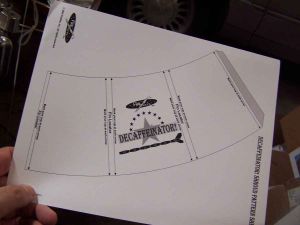
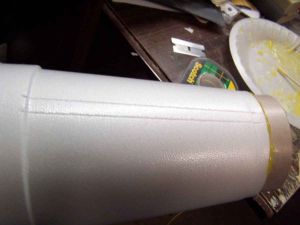
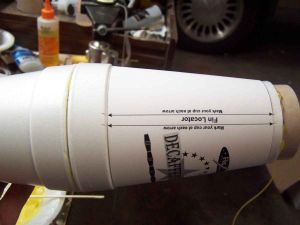
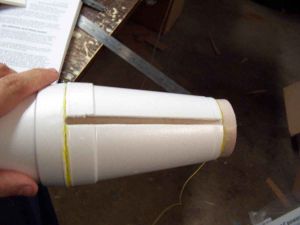
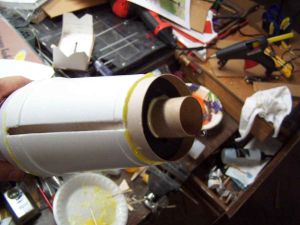
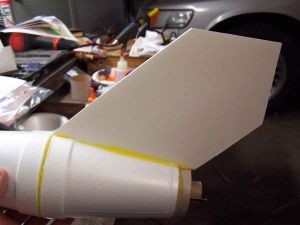
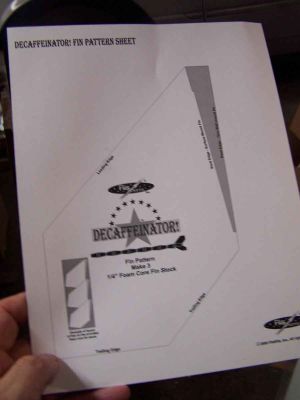
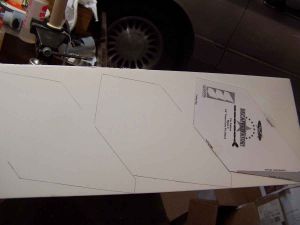

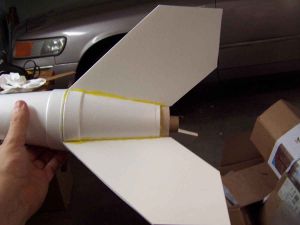
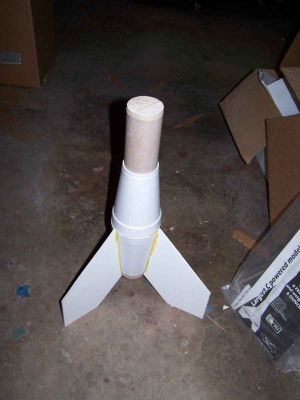
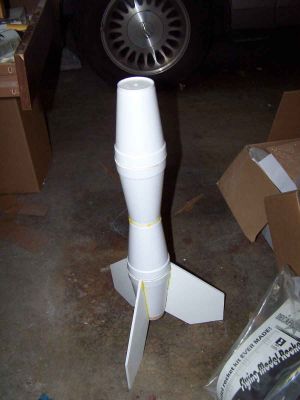
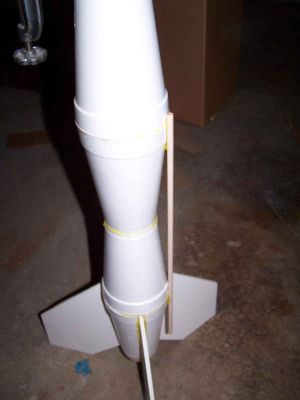
Finishing:
No finishing is really needed on this rocket. I suppose that I could find some foam safe paint and get rid of the
yellow from the glue but its not all that noticeable from any distance. I decided to leave mine bare.
Not long after completing this rocket, I saw a post from Jim Flis on TRF about finishing. He mentioned that electrical tape can be used to provide a little color and the strengthen the joints between cups. That seemed like a good idea to me and would cover up much of the glue mess.
I didn't have any colored tapes but I decided that I would be satisfied with black. Accordingly, I wrapped each cup joint with tape and the appearance was greatly improved.
Construction Rating: 5 out of 5
Flight:
I was a bit worried when the time came for the maiden flight. The wind had kicked up a bit. Mostly, I was worried
about the rocket being torn away from the lug on the launch rod. That did not occur.
I mounted a 12" chute and a C11-3. It was not a kid magnet because there were no kids present at that time, but it sure magnetized the adults. It took off well, did not weathercock at all, and ejected very nicely. It looked kind of funny coming down. Usually the rocket hangs under the chute canopy. This one kind of let its chute droop down below it. There was no damage. A video of the maiden flight can be seen here.
The second flight was on a D12-3. It was a repeat of the first one except higher. A good time was had by all. A video of the second flight can be seen here.
Other Reviews
- FlisKits Decaffeinator By Scott Turnbull
Brief: This is a 2nd Opinion review of the Fliskits Decaffeinator, a foam cup rocket with a 24mm motor mount. I made a couple of minor modifications to the design. This kit is pretty basic. At its core is the lengthy 24mm motor mount configured for rear ejection from a BT-70 body tube. Around that mount are a collection of foam core fins and Styrofoam cups. The assembled rocket stands over 6 ...
- FlisKits Decaffeinator By Joe Policy
The face card of this most unusual offering from FlisKits proclaims it is "nearly 6 feet tall and weighs only 6 ounces". This rocket is built out of Styrofoam coffee cups! The kit includes: 1 Nose Block 1 BT-50 Body Tube 1 BT-70 Body Tube 1 Launch Lug 2 Centering Rings 1 Engine Hook 1 Engine Block 1 16" Parachute Shroud Line Tape Disks 36" Shock Cord ...
 |
 |
Flights
Sponsored Ads
 |
 |











